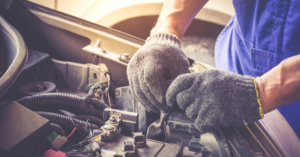A short guide through protective gloves used at work
Most of us think about gloves only with the approaching winter, but many people must use them in their everyday work all year round. Gloves are the most widely and eagerly used personal protection measures. Hands are body parts that are usually most exposed to various more or less harmful factors during the work. Apart from standard gloves, one can find fingerless gloves, bags;  finger, wrist, elbow, forearm and arm patches. In the past, apart from hand protection measures, hand pads and hand bags were also available. It is worth mentioning that not all gloves bought in a DIY shop are a personal protection measure within the meaning of OHS regulations applicable in Poland. Many of them are standard working gloves that protect only against dirt and substances harmless for human health. The following guide focuses on proper hand and wrist protection against the harmful effect of external factors, defined by the legislator.
finger, wrist, elbow, forearm and arm patches. In the past, apart from hand protection measures, hand pads and hand bags were also available. It is worth mentioning that not all gloves bought in a DIY shop are a personal protection measure within the meaning of OHS regulations applicable in Poland. Many of them are standard working gloves that protect only against dirt and substances harmless for human health. The following guide focuses on proper hand and wrist protection against the harmful effect of external factors, defined by the legislator.
The most important standard that applies to all gloves is EN 420, which specifies requirements, relevant research procedures related to the design and structure of gloves, water resistance of the used materials, harmlessness, comfort of use, marking and information added by the manufacturer to all protective gloves.
As regards the structure, the following types of protective gloves are available:
- one-finger,
- three-finger,
- five-finger,
- with shortened fingers,
As regards protective properties, the following protective gloves are available:
- gloves protecting against chemical and biological factors,
- gloves protecting against mechanical factors,
- gloves protecting against thermal factors,
- electrical insulation gloves,
- gloves intended for use in potentially explosive atmospheres,
- anti-vibration gloves.
How to select appropriate protective gloves?
It is not easy to select appropriate protective gloves, as several safety factors should be taken into account. An employer is obliged to select individual protection measures required at a given position. The appropriate selection of individual protection measures requires the collection and analysis of information directly related to the application of these measures at a given position.
When selecting gloves, one should take into account the following aspects:
- type of work,
- hand exposure level,
- risks related to a given work position,
- identifying the part of a hand with the highest exposition to dangerous factors, which makes it possible to select an appropriate glove structure.
Which elements of glove markings should we focus on?
Selecting protective gloves, we should take into account, in particular, properties such as:
- name, trademark other markings identifying the manufacturer or its authorised representative
- glove marking, trade name or code,
- size marking
- if necessary – expiry date
- A logo of a relevant standard (if a marking cannot be placed on a glove due to product properties, it can be placed on a packaging).
What should be taken into account during the purchase of gloves protecting against chemical and biological factors?
Gloves protecting against chemical and biological factors should meet the requirements of EN 374 standard related to: resistance to chemical factor penetration, infiltration resistance, minimum glove length and mechanical properties. The main function of gloves designed for the work with chemical and biological factors is to protect an employee’s hands against contact with these factors. According to EN 388 standard, gloves protecting against chemical and biological factors must meet requirements concerning resistance to abrasion, cuts and puncture as well as tearing resistance. Gloves protecting against chemical substances are made of plastic and rubber. Materials that are most frequently used for the production of gloves: latex, neoprene, vinyl (PCV), nitrile, PVA.
 How to choose gloves protecting against mechanical factors?
How to choose gloves protecting against mechanical factors?
Gloves protecting against mechanical factors should meet the requirements of EN 388 standard, i.e. abrasion, cuts or punctures. They provide protection against the following risks: abrasion, cuts, tears and punctures. Gloves protecting against mechanical risks are usually made of leather and fabrics, fabrics coated with plastic or rubber. This group includes also knitted gloves made of various kinds of yarn, e.g.: cotton, polyester, steelon, polyamide, aramid, corespun, polyethylene, of fibre glass, as well as mixed yarn including the above-mentioned raw materials.
the requirements concerning gloves protecting against mechanical injury are specified in the following standards:
- PN-EN 388 – gloves protecting against mechanical risks,
- PN-EN 381 – requirements for gloves protecting against a chainsaw cut,
- PN-EN 1082 – gloves and shoulder protection preventing cuts and punctures with manual knives,
- PN-EN 14328 – gloves and shoulder protection preventing cuts and punctures with driven knives.
What should be taken into account during the purchase of gloves protecting against thermal factors?
Gloves protecting against thermal factors can be divided into ones that protect against hot thermal factors and ones protecting against cold.
Gloves protecting against hot factors are ones that protect an employee’s hands against heat and/or fire that occur during the performance of the work in one or several forms, i.e.:
- open fire,
- contact with a hot item,
- convective heat,
- heat radiation,
- small sprays of melted metals,
- large quantities of liquid metal.
Gloves protecting against cold are used in order to ensure proper temperature of hand skin during the performance of works in low temperature or contact with cold surfaces. Appropriate temperature for the proper functioning of the hand and fingers is 32 ÷ 36°C. One of the most important functions of gloves is to prevent the fall of hand skin temperature. The minimum skin temperature is specified in PN-ISO 9886:2005 standard. In a cold environment, it should not be less than 15°C (especially for face and fingers). PN-EN 511:2006(U) standard specifies requirements that should me met by gloves protecting against cold.
Gloves protecting against the cold are all gloves that protect an employee’s hands against the cold that occurs during the performance of the work in one or several forms, i.e.:
- convective cold resistance,
- contact cold resistance,
- water permeation.
What is important when purchasing gloves protecting against electric shock?
Insulating gloves protect hands against electric shock. PN-EN 60903:2006 ‘Live Working. Gloves of insulating material’ is the basic standard specifying the requirements and methods of testing gloves protecting against electric shock.
According to PN-EN 60903:2006, there are two types of gloves:
- insulating five- or three-finger gloves to be used together with leather gloves put on them (insulating gloves),
- insulating five- and three-finger gloves used independently, without additional gloves. They also provide protection against electric shock and mechanical factors (composite gloves).
Categories of gloves for live working, depending on their special properties:
- category A – acid resistant gloves,
- category H – oil resistant gloves,
- category Z – ozone resistant gloves,
- category M – gloves with greater mechanical resistance,
- category R – acid, oil, ozone resistant gloves,
- category C – gloves resistant to extremely low temperature.
If gloves are colour coded, the colour of a double triangle should match the following code:
class 00 – beige,
class 0 – red,
class 1 – white,
class 2 – yellow,
class 3 – green,
class 4 – orange.
What should be taken into account when purchasing antistatic gloves?
Antistatic gloves are gloves designed for use in potentially explosive atmospheres according to the requirements of EN 420 standard. Antistatic properties are confirmed during tests, in accordance with the requirements concerning protective antistatic clothes (EN 1149-1, 2,3). There is no separate harmonised standard specifying the requirements and methods of testing antistatic properties of gloves. Antistatic properties are usually an additional feature, mainly of gloves protecting against chemical factors and mechanical injuries.
How to buy good anti-vibration gloves?
Anti-vibration gloves protect hands against mechanical vibrations of various frequencies. They limit the transmission of vibrations from vibration tool handles to the hands of persons using these tools. The use of anti-vibration gloves protects against permanent lesions in one’s body, called the vibration syndrome. Gloves can be recognised as having anti-vibration properties if they meet two criteria:
- they do not enhance vibrations transmitted from the handle to the operator’s hand within the frequency limits of 32-200 Hz,
- additionally, they reduce vibrations within the limits of 200-1250 Hz to values lower than 60% of the value of vibrations measured on the operator’s hand when he/she is working without a glove.
 The selection of protective gloves is influenced by numerous factors. Proper selection is not as easy as it seems. There is a wide range of protective gloves offered in the market, but are we able to select them properly, so that they provide the highest possible level of safety? Taking into account numerous aspects of such selection, if we have any doubts in this area, we should consult specialists, in order not to risk our and our employees’ health or life.
The selection of protective gloves is influenced by numerous factors. Proper selection is not as easy as it seems. There is a wide range of protective gloves offered in the market, but are we able to select them properly, so that they provide the highest possible level of safety? Taking into account numerous aspects of such selection, if we have any doubts in this area, we should consult specialists, in order not to risk our and our employees’ health or life.
Source:
- Directive 89/656/EWG of 30 November 1989.
- Directive 89/686/EWG of 21 December 1989.
- Website: www.ciop.pl.



 polski
polski  Deutsch
Deutsch  English
English 
